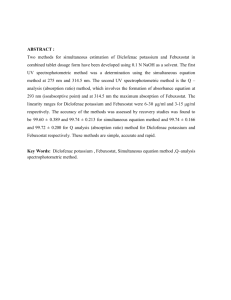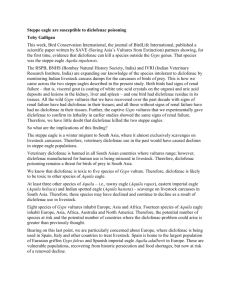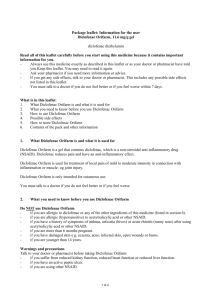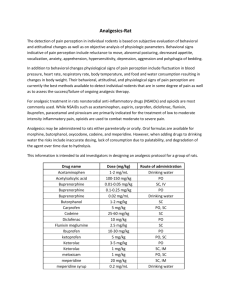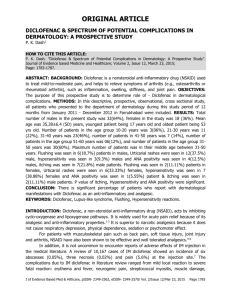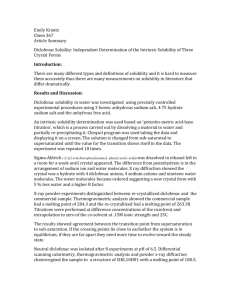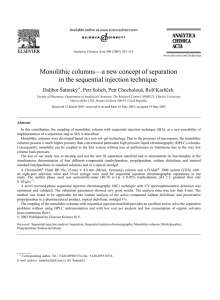Diclofenac Orifarm gel ENG
advertisement
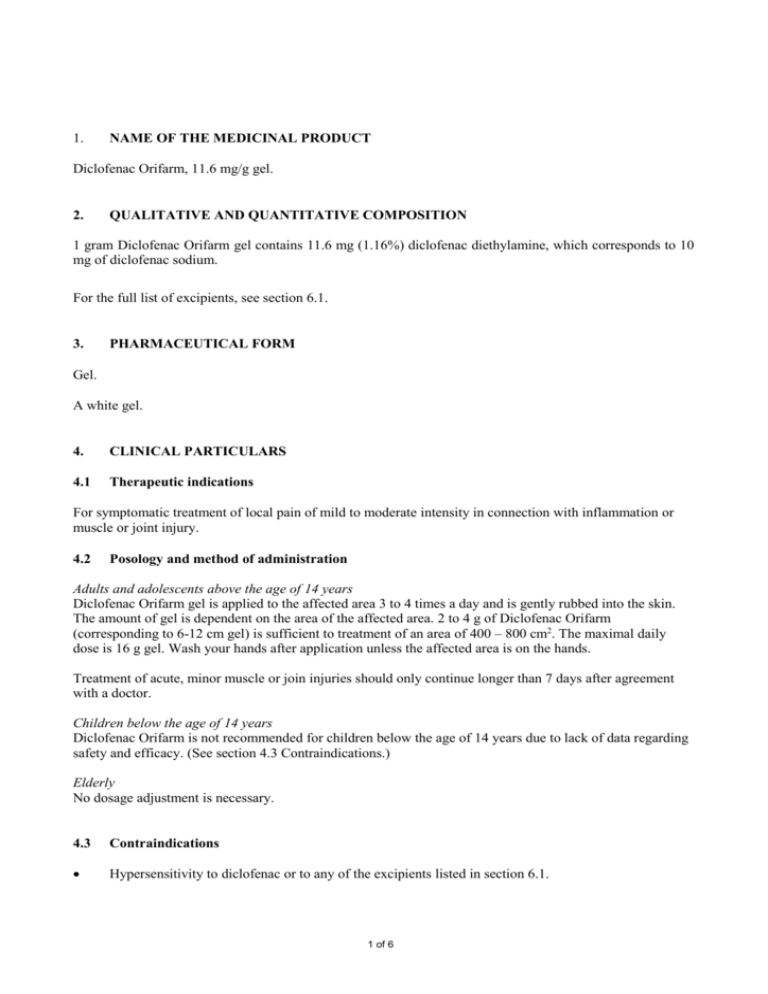
1. NAME OF THE MEDICINAL PRODUCT Diclofenac Orifarm, 11.6 mg/g gel. 2. QUALITATIVE AND QUANTITATIVE COMPOSITION 1 gram Diclofenac Orifarm gel contains 11.6 mg (1.16%) diclofenac diethylamine, which corresponds to 10 mg of diclofenac sodium. For the full list of excipients, see section 6.1. 3. PHARMACEUTICAL FORM Gel. A white gel. 4. CLINICAL PARTICULARS 4.1 Therapeutic indications For symptomatic treatment of local pain of mild to moderate intensity in connection with inflammation or muscle or joint injury. 4.2 Posology and method of administration Adults and adolescents above the age of 14 years Diclofenac Orifarm gel is applied to the affected area 3 to 4 times a day and is gently rubbed into the skin. The amount of gel is dependent on the area of the affected area. 2 to 4 g of Diclofenac Orifarm (corresponding to 6-12 cm gel) is sufficient to treatment of an area of 400 – 800 cm2. The maximal daily dose is 16 g gel. Wash your hands after application unless the affected area is on the hands. Treatment of acute, minor muscle or join injuries should only continue longer than 7 days after agreement with a doctor. Children below the age of 14 years Diclofenac Orifarm is not recommended for children below the age of 14 years due to lack of data regarding safety and efficacy. (See section 4.3 Contraindications.) Elderly No dosage adjustment is necessary. 4.3 Contraindications Hypersensitivity to diclofenac or to any of the excipients listed in section 6.1. 1 of 6 Hypersensitivity to acetylsalicylic acid or other non-steroidal anti-inflammatory drugs. Patients with a history of symptoms of asthma, urticaria or acute rhinitis after using acetylsalicylic acid or other non-steroidal anti-inflammatory drugs. Third trimester of pregnancy (see section 4.6) The gel should not be used on pathologically changed skin, e.g. eczema, acne, infected skin or open wounds or burns. Should not be used for children and adolescents under the age of 14 years. 4.4 Special warnings and precautions for use Contact with eyes and mucosa must be avoided and the medicinal product must not be taken orally. Direct sunlight or artificial sun should be avoided during treatment and two weeks after treatment to avoid the risk of photosensibility. The recommended treatment duration should not be exceeded because the risk of developing contact dermatitis increases over time. If a rash develops at any time during treatment the treatment should be stopped. The risk of systemic side effects caused by treatment with Diclofenac Orifarm cannot be excluded if the medicinal product is used on a large area of skin and for a longer duration. The gel should therefore be used with caution by patients with reduced renal function, reduced heart function or reduced liver function as well as patients with active peptic ulcers in the stomach or duodenum. Diclofenac Orifarm is not intended for use with occlusive bandages. Joint strains can be supported by bandage, but the winding must not be so hard that the blood circulation is stopped. Concomitant use of Diclofenac Orifarm and NSAID may increased the systemic adverse reactions and therefore the combination must be used with caution. Special attention should be given to the use of NSAID in elderly patients, as this group has a higher risk of developing adverse reactions. Diclofenac Orifarm contains propyleneglycol which may lead cause skin irritation. 4.5 Interaction with other medicinal products and other forms of interaction The systemic absorption of diclofenac from cutaenous gel treatment is very low. Therefore the risk of interactions with other medicinal products is small. Concomitant use of acetylsalicylic acid or other NSAID may lead to an increased risk of side effects. 4.6 Fertility, pregnancy and lactation Systemic concentrations of diclofenac are lower after use of Diclofenac Orifarm gel compared with oral preparations. The following recommendations apply to drug forms that result in systemic uptake: Pregnancy 2 of 6 Inhibition of prostaglandin synthesis may adversely affect pregnancy and/or embryo-foetal development when an NSAID is used. Data from epidemiological studies suggest an increased risk of miscarriage and of cardiac malformation and gastroschisis after use of a prostaglandin synthesis inhibitor in early pregnancy. The absolute risk of cardiovascular malformation was increased from less than 1% to approximately 1.5 %. The risk is believed to increase with a higher dose and duration of therapy. In animals, administration of a prostaglandin synthesis inhibitor has been shown to result in increased pre- and post implantation loss and embryo-foetal lethality. In addition, increased incidence of various malformations, including cardiovascular malformations, has been reported in animals exposed to a prostaglandin synthesis inhibitor during the organogenetic period. Topical use of Diclofenac Orifarm gel produces very low systemic blood levels. Nevertheless, Diclofenac Orifarm gel should only be used if absolutely necessary during the first and second trimester of pregnancy. The dose and the duration of therapy should be as low and as short as possible. During the third trimester of pregnancy, all prostaglandin synthesis inhibitors may expose the foetus to: Cardiopulmonary toxicity (with premature closure of the ductus arteriosus and pulmonary hypertension) Renal dysfunction, which may progress to renal failure with oligo-hydroamniosis. During the third trimester of pregnancy, all prostaglandin synthesis inhibitors may expose the mother and foetus, at the end of pregnancy, to: Prolongation of bleeding time, due to an anti-aggregating effect on thrombocytes, which may occur even at very low doses. Inhibition of uterine contractions, which may result in delayed or prolonged labour. In light of the above, Diclofenac Orifarm is contraindicated during the third trimester of pregnancy. Breast-feeding Diclofenac is secreted into human milk, but risk of affecting the child appears unlikely when therapeutic doses are administered to the mother. Diclofenac Orifarm must not be applied to the breasts of lactating women. 4.7 Effects on ability to drive and use machines Diclofenac Orifarm has no influence on the ability to drive and use machines. 4.8 Undesirable effects Like all medicines Diclofenac Orifarm can lead to side effects, although not everybody gets them. The side effects are listed below according to system organ class and frequency. The frequencies are defined as: Very common (≥1/10), Common (≥1/100 to <1/10), Uncommon (≥1/1,000 to <1/100), Rare (≥1/10,000 to <1/1,000), Very rare (<1/10,000) and Not known (cannot be estimated from the available data. System organ class Infections and infestations Immune system disorders Frequency Very rare Very rare Reaction Pustular rash Hypersensitivity (including urticaria), angioedema 3 of 6 Skin and subcutaneous tissue disorder Unknown frequency Common Uncommon Rare Very rare Respiratory, thoracic and mediastinal disorders General disorders and administration side conditions Very rare Uncommon Anaphylactic reactions Rash, eczema, erythema, dermatitis (including contact dermatitis), pruritus Redness, petechia, allergic dermatitis Bullous dermatitis Light sensitivity reactions, urticaria, dry skin Asthma, bronchospasm Burning sensation at the application site There is a risk of systemic reactions in long-term treatment (> 3 weeks) or when large areas of skin is treated (e.g. more than 600 cm2 of surface). Reactions such as stomach pain, dyspepsia, gastric or renal disturbances may occur. 4.9 Overdose The low systemic absorption of topical diclofenac makes overdose very unlikely to happen. It diclofenac gel is swallowed the same adverse reactions as with systemic diclofenac can occur. If significant systemic reactions occur the same precautions as in overdose with NSAID should be taken and the use of active charcoal can be considered. 5. PHARMACOLOGICAL PROPERTIES 5.1 Pharmacodynamic properties Pharmacotherapeutic group: anti-inflammatory preparations, non-steroids for topical use, ATC code: M02AA15. Diclofenac is a non-steroidal anti-inflammatory drug (NSAID) with analgesic, anti-inflammatory and antipyretic properties. Inhibition of the prostaglandin synthesis is the primary action mechanism of diclofenac. Diclofenac Orifarm is only recommended for cutaneous use. 5.2 Pharmacokinetic properties Absorption The amount of diclofenac that is absorbed systemically from diclofenac gel is proportionl to the area of skin that is being treated and is dependent on both the applied total dose and the degree of moisture of the skin. The absorption is approximately 6 percent of the diclofenac dose following cutaneous application of 2.5 g of diclofenac gel on 500 cm2 skin as measured by total renal elimination compared with diclofenac tablets. Ten hours of occlusion leads to a three-fold increase in absorption of diclofenac. Distribution 4 of 6 The concentration of diclofenac has been measured in plasma; synovial tissue and synovial fluid after cutaneous administration of diclofenac gel on hand and knee joints. The maximal plasmaconcentration is approximately 100 times less than for oral administration of the corresponding amount of diclofenac. Diclofenac is 99.7 % bound to serum proteins, predominantly albumin (99.4 %). Metabolism The biotransformation of diclofenac occurs partly by glucuronidation of the intact molecule but the main route is simple and multiple hydroxylations. This results in several phenol-metabolites, of which the majority is converted to glucuronide conjugates. Two of these phenol-metabolites are biologically active but in much less degree than diclofenac. Elimination The total clearance of diclofenac from plasma is 263 ± 56 ml/min. The terminal half-life in plasma is 1-2 hours. Four of the metabolites, including the two active metabolites, also have a short plasma half-life of 1-3 hours. One metabolite, 3'-hydroxy-4'-methoxy-diclofenac, has a longer half-life but is practically inactive. Approximately 60 % of the administered dose is excreted in urine in the form of metabolites. Less than 1 % is excreted as unchanged diclofenac. The rest of the dose is excreted as metabolites in bile and faeces. Reduced renal function No accumulation of diclofenac or its metabolites is expected in patients with reduced renal function. Reduced hepatic function The pharmacokinetic and metabolism of diclofenac is the same in patients with chronic hepatitis or uncompensated cirrhosis as for patients without liver disease. 5.3 Preclinical safety data There are no preclinical safety data that are deemed to have a significant impact on clinical safety in addition to the information provided in other parts of the summary of product characteristics. 6. PHARMACEUTICAL PARTICULARS 6.1 List of excipients Carbomer Cocoyl caprylocaprate Diethylamine Isopropyl alcohol Macrogol cetostearyl ether Paraffin, liquid Propylene glycol Water, purified 6.2 Incompatibilities Not applicable. 5 of 6 6.3 Shelf life 3 years. 6.4 Special precautions for storage This medicinal product does not require any special storage conditions. 6.5 Nature and contents of container Tube: Aluminium tube with a PP screw cap closure. Pack size: 50 g or 100 g. Not all pack sizes may be marketed. 6.6 Special precautions for disposal No special requirements. 7. MARKETING AUTHORISATION HOLDER Orifarm Generics A/S Energivej 15, POB 69 DK-5260 Odense S Denmark 8. MARKETING AUTHORISATION NUMBER(S) [To be completed nationally] 9. DATE OF FIRST AUTHORISATION/RENEWAL OF THE AUTHORISATION [To be completed nationally] 10. DATE OF REVISION OF THE TEXT 2012-09-28 6 of 6
